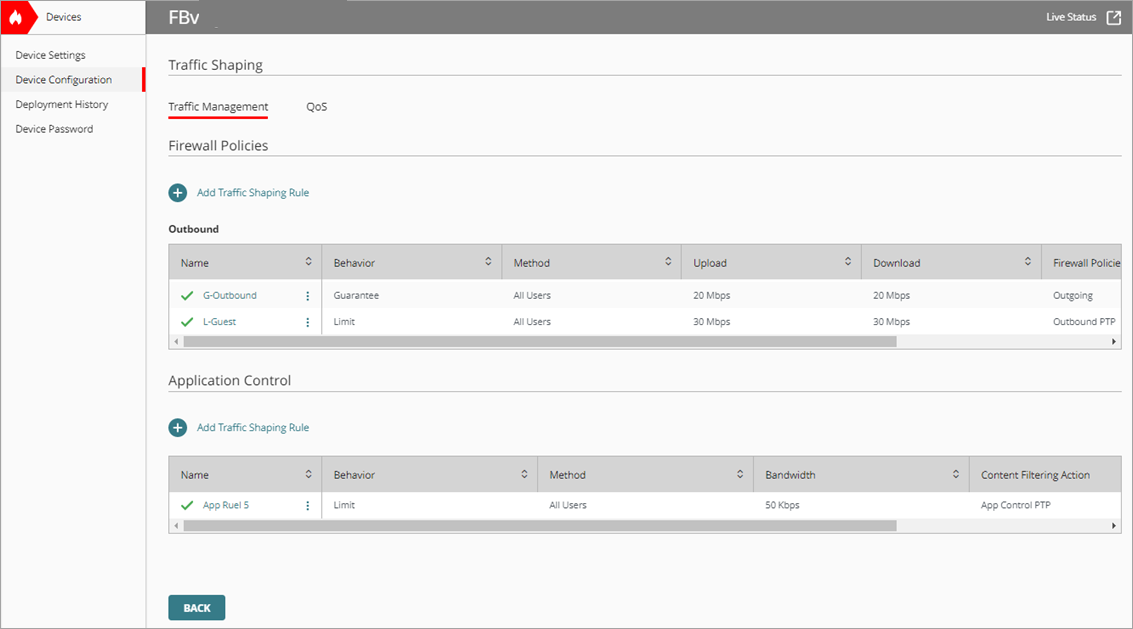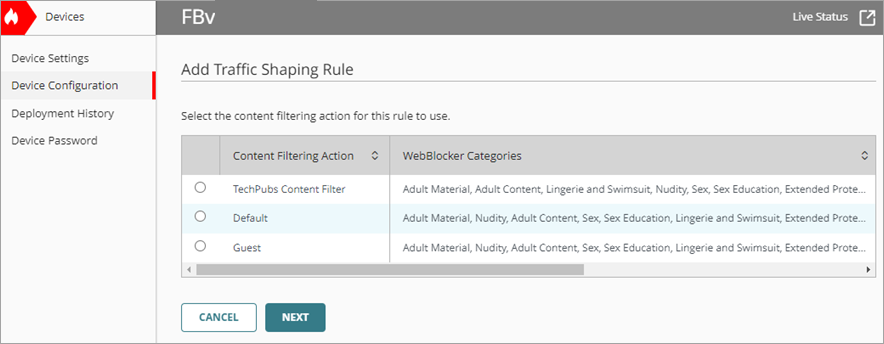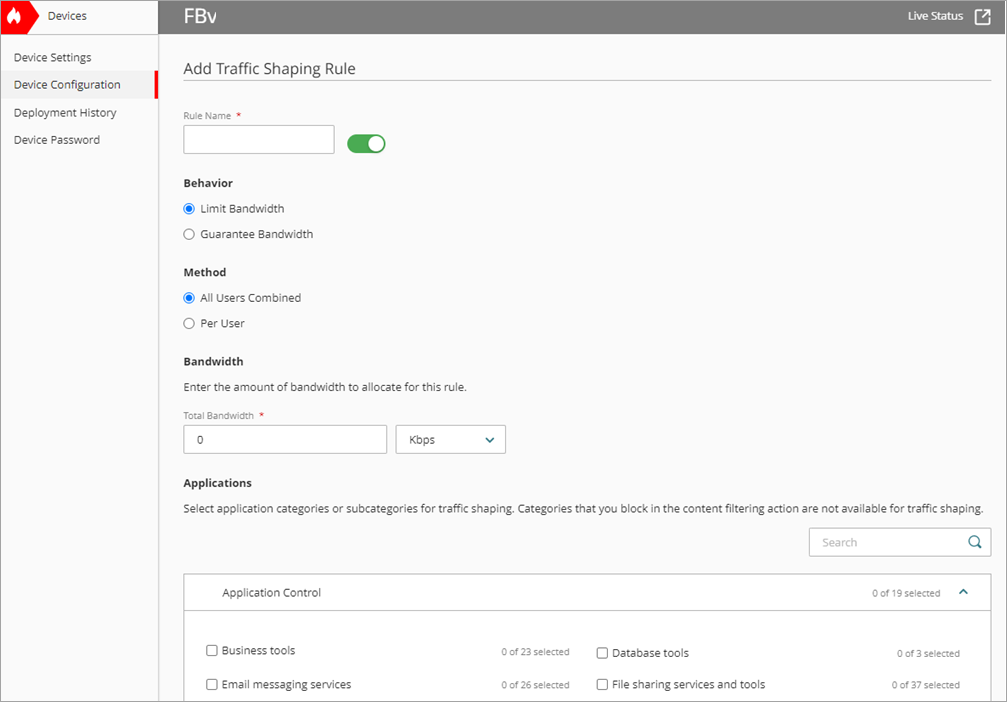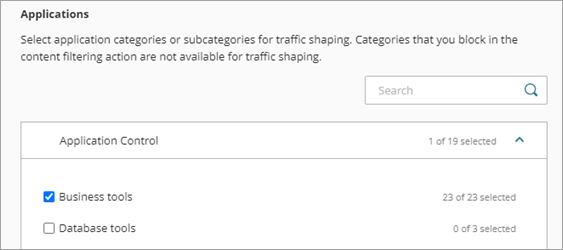Applies To: Cloud-managed Fireboxes
In WatchGuard Cloud, you can configure traffic shaping rules to control bandwidth used by specific applications or application categories. When you use the Traffic Shaping feature with Application Control, the rule allows application traffic, but the traffic is subject to the bandwidth settings in the traffic shaping rule. If you apply a traffic shaping rule to an application category, all applications in that category share the bandwidth settings.
Before you can use a traffic shaping rule with Application Control, you must first create a content filtering action for the rule to use. From the traffic shaping rule, you can then select the content filtering action and the application categories, subcategories or individual applications to apply the rule to. For more information, go to Configure Content Filtering in WatchGuard Cloud.
Both the bandwidth limit and bandwidth guarantee apply only if the necessary bandwidth is available through the interface that handles the traffic. Before you implement Traffic Shaping, make sure you know the available bandwidth on the network, then determine how much bandwidth you want to guarantee or limit.
Add a Traffic Shaping Rule for Applications
To add a traffic shaping rule for a content filtering action, from WatchGuard Cloud:
- From Account Manager, select the account you want to add traffic shaping rules to.
- Select Configure > Devices.
- Select the cloud-managed Firebox that you want to create a traffic shaping rule for.
- Click Device Configuration.
The Device Configuration page opens. - Click the Traffic Shaping tile.
The Traffic Shaping page opens.

- From the Application Control section, click Add Traffic Shaping Rule.
The Add Traffic Shaping Rule page opens. - Select the content filtering action for the rule to use.

- Click Next.
The Add Traffic Shaping Rule page opens.

- In the Rule Name text box, type a name for the rule.
- In the Behavior section, select either Limit Bandwidth or Guarantee Bandwidth.
- Limit Bandwidth — Set a maximum bandwidth limit that you want to allocate for traffic.
- Guarantee Bandwidth — Set a minimum bandwidth guarantee that you want to allocate for traffic.
- In the Method section, select either All Users Combined or Per User.
- All Users Combined — Set restrictions for bandwidth usage for all users combined. The bandwidth speed you define applies to all users in the policy that use the traffic shaping rule.
- Per User — Set restrictions for bandwidth usage for each user. The bandwidth speed you define applies to each individual user of the policy that uses the traffic shaping rule.
The total bandwidth available to each user equals the maximum number of users multiplied by the bandwidth that you enter. If the number of actual users exceeds the maximum users, the first and last users share bandwidth.
- In the Bandwidth section and the adjacent drop-down list, specify the total bandwidth to allocate for traffic.
- In the Applications section, select the application categories, subcategories or individual applications that this rule applies to. To select a subcategory, click
 next to a category.
next to a category.

- Click Save.
The new rule shows in the Traffic Shaping Rules list .

To create traffic shaping rules for multiple cloud-managed Fireboxes, you can add or edit a Firebox template. The Traffic Shaping feature is available from a Firebox template. For more information, go to About Firebox Templates.
If you use a template to create a traffic shaping rule, you must also use the template to edit or delete the rule. If you disable a traffic shaping rule in a template, the rule does not show on the device.
Disable a Traffic Shaping Rule
In WatchGuard Cloud, you can disable a traffic shaping rule from the Traffic Management page.
To disable a traffic shaping rule from the Traffic Management page, from WatchGuard Cloud:
- Select Configure > Devices.
- Select a cloud-managed Firebox that you want to disable Traffic Shaping for.
- Click Device Configuration.
The Device Configuration page opens. - Click the Traffic Shaping tile.
The Traffic Shaping page opens. - From the Traffic Management page, click
 next to the name of a rule and select Disable.
next to the name of a rule and select Disable.

Delete a Traffic Shaping Rule
You can delete a traffic shaping rule from the Traffic Shaping page.
To delete a traffic shaping rule:
- On the Traffic Shaping page, from the Application Control section, click the name of a rule you want to delete.
The configuration page for the rule opens. - From Applications, clear the check box for any Application Control category to which the rule currently applies. Click Save.

Before you can delete a traffic shaping rule for an application, you must first clear the check box for any Application Control category that you selected in the rule.
- On the Traffic Shaping page, from the Application Control section, click
 next to the name of the rule, and select Delete.
next to the name of the rule, and select Delete.

- In the Delete dialog box, click Delete.
The rule is removed from the Traffic Shaping Rules list.